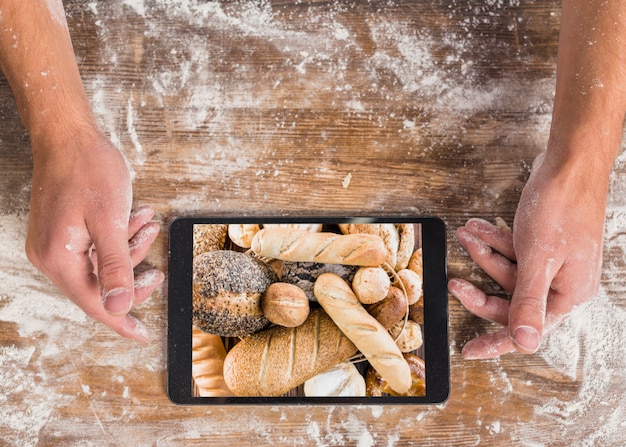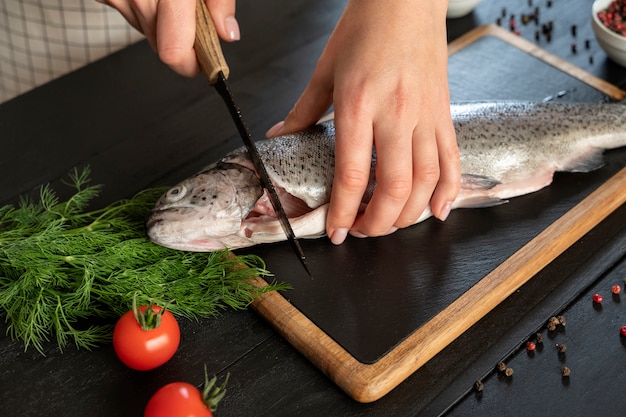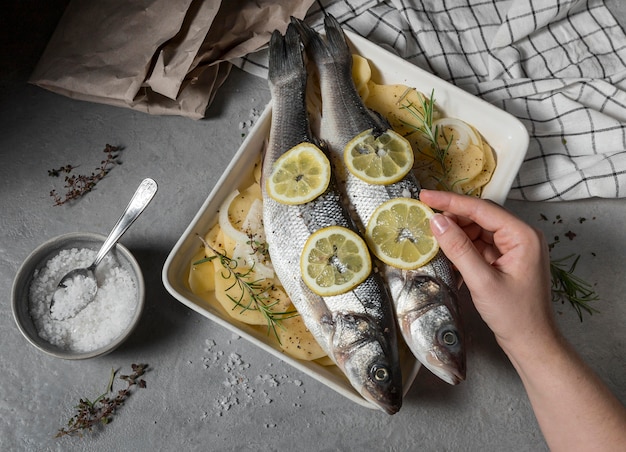Let’s talk about flounder. You know, those flat, delicate fish that sometimes get overlooked at the market? Maybe it’s because they don’t have the same "wow factor" as some of their flashier fishy cousins. But trust me, don’t let that fool you. Flounder is a true gem in the world of seafood. It’s delicate, it's versatile, and it's absolutely delicious when cooked right.
And the best part? It's super easy to bake in the oven. No fancy pans, no complicated techniques, just a simple and straightforward method for a truly delightful meal. I’ve been cooking flounder for years, and I’ve learned a few tricks along the way. I’m going to share those secrets with you, along with some of my favourite recipes that are guaranteed to impress your taste buds.
(Part 1) Why Flounder?

A Taste of the Sea
So why am I such a big fan of flounder? Well, it’s not just because it’s easy to cook. It’s also because it’s a real flavour bomb. The taste is light and sweet, almost like the sea itself. It’s not overly fishy, which is great if you're not a huge fan of that strong fishy taste. But the best part? It absorbs flavours like a sponge, so you can really experiment with different seasonings and sauces.
Imagine a delicate, flaky white fish that melts in your mouth, carrying with it the subtle sweetness of the ocean and the vibrant notes of your chosen flavours. That's the magic of flounder!
A Healthier Choice
I’m a big believer in eating healthy, and flounder is definitely on my list of good-for-you foods. It’s packed with protein, omega-3 fatty acids (good for your brain!), and it’s naturally low in calories and fat. It’s also a great source of vitamins and minerals, like vitamin D, selenium, and potassium, making it a real winner for a nutritious meal.
Affordable and Accessible
Let’s be real, we all love a good bargain. And flounder is often one of the most affordable fish you can find. You can usually pick it up fresh at your local market, or you can find it frozen at most supermarkets. Plus, with a little bit of creativity, flounder can stretch far, making it a versatile and budget-friendly ingredient.
(Part 2) Oven-Baked Flounder: A Simple Guide

Now, let's get down to the nitty-gritty. Baking flounder is so easy, it’s almost foolproof. I promise, even if you’re a kitchen novice, you can do this.
The Essential Ingredients
Here are the basic ingredients you’ll need for your oven-baked flounder:
- Fresh or frozen flounder fillets (about 4-6 ounces per fillet)
- Olive oil or another neutral cooking oil
- Salt and freshly ground black pepper
And that’s it! You can add more flavour if you like, but these are all you really need to get started.
The Baking Process
Here’s the step-by-step process:
- Preheat your oven to 400 degrees Fahrenheit (200 degrees Celsius).
- Line a baking sheet with parchment paper or aluminium foil. This will make clean-up a breeze!
- Place the flounder fillets on the prepared baking sheet. If using frozen fillets, make sure to thaw them completely first.
- Drizzle a little olive oil over the fillets and season generously with salt and pepper.
- Bake for 10-15 minutes, or until the fish is cooked through and flakes easily with a fork.
It's as simple as that! You can add lemon juice, herbs, or spices to your liking. Just remember to keep an eye on the oven to ensure it doesn't dry out.
(Part 3) Flavour Explosion: Oven-Baked flounder recipes

Right, now we’re getting to the fun part! Here are a few of my favourite oven-baked flounder recipes that are sure to impress:
Classic Lemon Herb Flounder
This is a true classic for a reason. The bright flavour of lemon and the aromatic herbs are the perfect match for the delicate taste of flounder.
Ingredients:
- Flounder fillets
- Olive oil
- Salt and freshly ground black pepper
- 1 lemon, thinly sliced
- 1 tablespoon chopped fresh parsley
- 1 teaspoon chopped fresh dill
Instructions:
- Preheat oven to 400 degrees Fahrenheit (200 degrees Celsius).
- Line a baking sheet with parchment paper or aluminium foil.
- Place the flounder fillets on the prepared baking sheet.
- Drizzle olive oil over the fillets and season with salt and pepper.
- Top each fillet with a lemon slice, parsley, and dill.
- Bake for 10-15 minutes, or until the fish is cooked through and flakes easily with a fork.
Serve with a side of roasted vegetables or a green salad. The acidity of the lemon will cut through the richness of the fish, while the herbs add a layer of freshness that enhances the delicate flavour.
Mediterranean Flounder with Olives and Capers
For a taste of the Mediterranean, try this recipe. The salty olives and tangy capers add a delightful depth of flavour to the flounder.
Ingredients:
- Flounder fillets
- Olive oil
- Salt and freshly ground black pepper
- 1/2 cup pitted Kalamata olives, sliced
- 2 tablespoons capers, rinsed
- 1 tablespoon chopped fresh oregano
Instructions:
- Preheat oven to 400 degrees Fahrenheit (200 degrees Celsius).
- Line a baking sheet with parchment paper or aluminium foil.
- Place the flounder fillets on the prepared baking sheet.
- Drizzle olive oil over the fillets and season with salt and pepper.
- Top each fillet with olives, capers, and oregano.
- Bake for 10-15 minutes, or until the fish is cooked through and flakes easily with a fork.
Serve with a side of couscous or a Mediterranean-style salad. The combination of olives, capers, and oregano creates a salty, tangy, and aromatic flavour profile that transports you to the sun-drenched shores of the Mediterranean.
Spicy Asian-Inspired Flounder
For a bit of heat, try this spicy Asian-inspired recipe. The ginger and chilli flakes add a real kick, while the soy sauce and sesame oil bring a delicious umami flavour.
Ingredients:
- Flounder fillets
- Olive oil
- Salt and freshly ground black pepper
- 1 tablespoon soy sauce
- 1 tablespoon sesame oil
- 1 teaspoon grated ginger
- 1/2 teaspoon red pepper flakes (adjust to your spice preference)
- 1 tablespoon chopped green onions
Instructions:
- Preheat oven to 400 degrees Fahrenheit (200 degrees Celsius).
- Line a baking sheet with parchment paper or aluminium foil.
- Place the flounder fillets on the prepared baking sheet.
- In a small bowl, whisk together the soy sauce, sesame oil, ginger, and red pepper flakes.
- Pour the sauce over the flounder fillets.
- Bake for 10-15 minutes, or until the fish is cooked through and flakes easily with a fork.
- Sprinkle with green onions before serving.
Serve with a side of brown rice or steamed vegetables. The ginger and chilli flakes add a fiery kick that's balanced by the salty soy sauce and the nutty sesame oil.
(Part 4) Going Beyond the Basics: Flounder Variations
Let's be honest, once you’ve mastered the basics, it’s time to get creative. You can use your favourite flavour combinations or try some new things.
Flavour Boosters
Here are some extra ingredients you can add to your oven-baked flounder:
- Garlic: A classic flavour enhancer. Simply mince a clove or two and add it to the olive oil before you drizzle it over the fillets.
- Fresh herbs: Rosemary, thyme, sage, basil, oregano, parsley – the possibilities are endless! Use them fresh or dried, depending on your preference.
- Citrus: Lemon, lime, orange – add a bright zing to your flounder. Thinly sliced citrus fruits make a beautiful and flavourful garnish, while their juices can be used to create a tangy sauce.
- Vegetables: Chopped tomatoes, mushrooms, peppers, onions, zucchini – get creative with your veggies. Roasting them alongside your flounder adds a depth of flavour and texture.
- Spices: Paprika, cumin, coriander, curry powder – add a touch of warmth and complexity. Experiment with different spice blends to find your favourite flavour profiles.
Different cooking techniques
If you're feeling adventurous, try these variations:
- Pan-frying: For a crispy exterior, pan-fry your flounder fillets in a bit of oil. Make sure to heat the pan before adding the fillets, and don't overcrowd the pan.
- Grilling: For a smoky flavour, grill your flounder fillets over medium heat. Use a grill pan or a barbecue grill, and make sure to brush the fillets with olive oil before grilling.
- Sautéing: Sauté your flounder fillets with some aromatics for a quick and easy meal. Add some chopped garlic, onions, and peppers to the pan with a little olive oil, then add the fillets and cook until they are opaque.
(Part 5) Flounder: More than just a Dinner
So far, we’ve been focusing on flounder as the star of the dinner show, but it’s so much more than that.
Fish Tacos
These are a crowd-pleasing favourite. Simply flake some cooked flounder and mix it with your favourite taco toppings. I love to use a spicy slaw, creamy avocado, and a squeeze of lime.
Fish Sandwiches
Flounder makes a great filling for sandwiches. You can use it in a classic fish sandwich, or get creative with your toppings. Try adding aioli, pickled onions, and lettuce for a gourmet twist.
Fish Soup
A light and flavourful soup, perfect for a chilly day. Add some flounder to your favourite soup recipe for a delicious and healthy meal. I love to make a simple fish soup with tomatoes, onions, garlic, and herbs.
Fish Salads
Add some flaked flounder to your favourite salad for a protein boost. A salad with flounder, roasted vegetables, and a light vinaigrette is a healthy and satisfying meal.
(Part 6) The Importance of Quality
Now, let's talk about the importance of using good-quality flounder. If you’re going for fresh, look for fillets that are bright, firm, and smell fresh. If you’re going for frozen, make sure it’s properly sealed and not freezer burnt.
When choosing your flounder, I always prefer to go to my local fishmonger. They’re usually more knowledgeable about the fish and can offer great advice on how to cook it. They can also tell you about the seasonality and sustainability of the fish, ensuring you are making an environmentally responsible choice.
(Part 7) Storage and Handling
Once you’ve got your flounder, it’s important to handle it properly.
fresh flounder
Fresh flounder should be stored in the refrigerator for no more than 1-2 days. Wrap it tightly in plastic wrap or store it in an airtight container. Keep it in the coldest part of your fridge, ideally at or below 40 degrees Fahrenheit (4 degrees Celsius).
Frozen Flounder
Frozen flounder can be stored in the freezer for up to 3-4 months. Make sure to thaw it completely in the refrigerator before cooking. Do not thaw frozen flounder at room temperature, as this can create a breeding ground for bacteria.
(Part 8) Serving Suggestions
Right, so your oven-baked flounder is cooked to perfection. Now what? It's all about creating a delicious and balanced meal.
side dishes
Here are some side dishes that pair well with flounder:
- Roasted vegetables: Broccoli, asparagus, carrots, zucchini, Brussels sprouts – the possibilities are endless! Roasting vegetables in the oven alongside your flounder will create a harmonious symphony of flavors and textures.
- Green salad: A simple and refreshing side. A classic green salad with a light vinaigrette is the perfect complement to the delicate flavour of flounder.
- Rice: Brown rice, white rice, wild rice – the choice is yours. Rice adds a comforting and hearty element to your meal.
- Pasta: A hearty and satisfying option. A simple pasta dish with garlic and olive oil will complement the flounder beautifully.
- Couscous: A light and fluffy side dish. Couscous is a versatile grain that can be dressed up with herbs, spices, or citrus.
Sauces and Toppings
For an extra burst of flavour, try adding a sauce or topping:
- Lemon butter sauce: A classic and simple sauce. Simply melt butter with lemon juice and herbs for a flavourful and easy sauce.
- Garlic herb sauce: A fragrant and flavorful sauce. Combine chopped garlic, herbs, and olive oil for a delicious and aromatic sauce.
- Spicy chili sauce: For a touch of heat. Add a dash of your favourite chili sauce to your flounder for a spicy kick.
- Creamy dill sauce: A tangy and creamy sauce. Combine sour cream or yogurt with chopped dill for a refreshing and creamy sauce.
- Salsa: A fresh and vibrant topping. Top your flounder with your favourite salsa for a burst of colour and flavour.
Drinks
And let's not forget about the drinks! Here are some suggestions for pairing your oven-baked flounder:
- White wine: A dry white wine like Sauvignon Blanc or Pinot Grigio will complement the delicate flavour of the flounder. The crisp acidity of these wines will cut through the richness of the fish.
- Rosé wine: A light and refreshing rosé will also work well. Rosé wines offer a delicate fruitiness that complements the subtle flavour of flounder.
- Beer: A crisp and light beer like a Lager or Pilsner will go well with the fish. These beers have a refreshing, clean flavour that won’t overpower the fish.
(Part 9) Flounder: A culinary adventure
Okay, so you've got your recipe, your side dishes, and your drinks – you’re all set for a delicious and satisfying meal. But remember, cooking is all about experimentation and having fun. Don't be afraid to try new things and let your creativity shine.
Tips for Success
Here are a few final tips for cooking oven-baked flounder:
- Don't overcook the fish. Overcooked flounder can become dry and rubbery. It’s best to err on the side of undercooked, as you can always cook it a little longer if needed.
- Use a good-quality fish. The quality of the fish will make a big difference in the taste of your meal. Look for fillets that are firm, have a fresh smell, and are free of any blemishes.
- Don't be afraid to experiment with flavours. Try different combinations of spices, herbs, and sauces to find your favourites. The beauty of flounder is that it is so versatile.
- Have fun! Cooking should be enjoyable, so relax and enjoy the process. There's nothing quite like the satisfaction of creating a delicious meal from scratch.
(Part 10) FAQs
You’ve got questions, I’ve got answers!
1. Can I bake flounder with the skin on?
Yes, you can bake flounder with the skin on, but it's not essential. If you do bake it with the skin on, it will help to keep the fish moist and prevent it from sticking to the baking sheet. Just make sure to score the skin a few times with a sharp knife before baking to prevent it from curling up. You can also remove the skin after baking if you prefer.
2. How can I tell if the flounder is cooked through?
The fish should be opaque and flake easily with a fork. You can also use a meat thermometer to check the internal temperature, which should be 145 degrees Fahrenheit (63 degrees Celsius). Be careful not to overcook the fish, as it can become dry and rubbery.
3. Can I freeze cooked flounder?
Yes, you can freeze cooked flounder. Let it cool completely, then wrap it tightly in plastic wrap and store it in an airtight container in the freezer for up to 3-4 months. When you’re ready to eat it, thaw it in the refrigerator overnight and reheat it gently in the oven or microwave.
4. Can I bake flounder in a different shape pan?
Of course! If you want to use a different shape pan, just adjust the baking time accordingly. Just make sure there's enough space between the fillets for the heat to circulate evenly. A larger pan may require a slightly longer baking time, while a smaller pan may require a slightly shorter baking time.
5. What are some other types of fish that are similar to flounder?
Flounder is a member of the flatfish family, which also includes sole, halibut, and turbot. These fish are all similar in texture and flavour, and they can be cooked using the same methods. However, they may have different cooking times, so it's always best to check the recipe before cooking.
Well, there you have it! I hope you’ve enjoyed this journey into the world of oven-baked flounder. Remember, the best recipes are the ones you create yourself, so don’t be afraid to experiment and find your own favourites. Happy cooking!
Everyone is watching

Perfect Rice Every Time: The Ultimate Guide to Cooking Rice
Cooking TipsAs a self-proclaimed foodie, I've always been a bit obsessed with rice. It's the foundation of countless cuisi...

The Ultimate Guide to Cooking Asparagus: Tips, Techniques, and Recipes
Cooking TipsAsparagus. The mere mention of this spring delicacy conjures up images of vibrant green spears, crisp and burs...

Ultimate Guide to Cooking the Perfect Thanksgiving Turkey
Cooking TipsThanksgiving. Just the word conjures up images of overflowing tables laden with delicious food, the scent of r...

Prime Rib Roast Cooking Time Chart: Per Pound Guide
Cooking TipsPrime rib roast. Just the name conjures images of lavish dinners, crackling fires, and hearty laughter. It’s ...

Can You Cook Spaghetti with Gasoline? (The Shocking Truth)
Cooking TipsWe've all seen those crazy internet trends. You know, the ones that make you wonder, "Did someone actually try...
